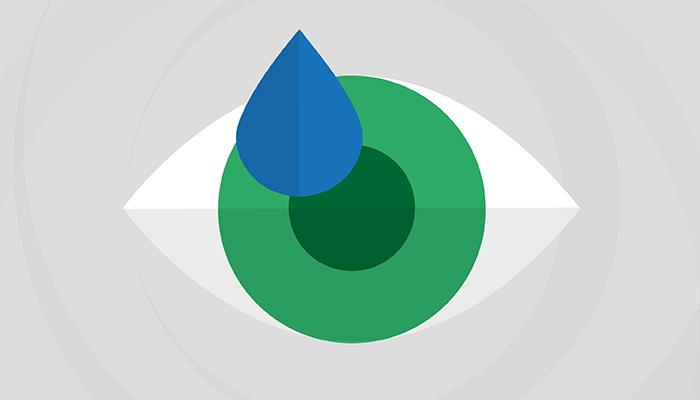
When I asked a new dry eye patient which treatments she’d tried recently, she told me she was using store-brand redness relief eye drops several times a day. The drops contained saline, a vasoconstrictor, preservatives, and other additives. I explained, “Inflammation is making your eyes red. Although these drops make them temporarily less red, they don’t offer adequate lubrication – and their ingredients can actually increase inflammation.”
Instead of helping her condition, my patient was actually making it worse. Unfortunately, this is rather common. When it comes to eye drops, consumers have lots of options, many of which don’t offer the benefits they need and contain preservatives that can cause toxicity with frequent use. As a dry eye specialist, my approach to recommending specific types of quality artificial tears is based around the following points.
1. Know what to look for
The TFOS DEWS II report lays out the components of artificial tears and their importance (1). In addition to water, artificial tears include a range of other ingredients that we can easily find in current products.
DEWS II explains that, as a viscosity-enhancing agent and lubricant, naturally occurring hyaluronic acid (HA) has been shown to “bind to ocular surface cells,” offer healing properties, and “improve dry eye symptoms.” The study also specifically calls out the natural osmoprotectant trehalose for its water retention, bioprotective properties, protection of corneal cells from desiccation, acceleration of corneal healing, and contribution to restoring osmotic balance and homeostasis.
On the negative side, DEWS II notes that “chronic exposure of the ocular surface to preservatives is now well recognized to induce toxicity and adverse changes to the ocular surface.” This is important to me; after diagnosis, I start patients on frequent, proactive use of tears for immediate relief, while simultaneously pursuing treatments that address the underlying cause of their dry eye. Patients with mild dry eye might use tears once or twice a day and at bedtime, while patients with moderate to severe disease can use drops up to every hour to replenish their tear film. Even after we bring their dry eye under control, they will continue to routinely use artificial tears, and I prefer they avoid preservatives.
2. Choose the most beneficial product
In our referral practice, most patients have moderate to severe dry eye disease. Many have seen multiple doctors, searching for a therapeutic approach that works, and they need the right combination of therapies.
I have all patients use a heat mask (Bruder) and eyelid cleanser at home. Depending on the nature of their condition (aqueous deficient dry eye or evaporative disease caused by meibomian gland dysfunction), I might recommend an in-office therapy, such as thermal pulsation (LipiFlow, Johnson & Johnson Vision; TearCare, Sight Sciences) to clear the glands of inspissated meibum, a short course of topical corticosteroids (Eysuvis, Kala Pharmaceuticals) to reduce surface inflammation, and/or topical immunomodulators, such as cyclosporine (Cequa, Sun Pharmaceuticals; Restasis, Allergan), and lifitegrast (Xiidra, Novartis) to help reduce inflammation and stimulate tear production.
In addition, I always recommend starting with high-frequency, preservative-free lubricant eye drops, as well as a gel or ointment for nighttime lubrication. I explain to patients that there are a handful of artificial tears that are most beneficial for their condition, emphasizing for frequent use patients that they should only use tears that are clearly labeled preservative-free. By avoiding preservative-related toxicity, patients can be sure that the tears are safe to use with high frequency.
I’ve recently been recommending iVizia (Thea), a newer artificial tear that contains both HA and trehalose as described in DEWS II, which has received great feedback from my patients. I’ll also point to Refresh (Allergan) and Systane (Alcon), which contain HA, TheraTears (Alcon), which has trehalose, and several other preservative-free tears. I advise patients to avoid any generic artificial tears, as they may contain preservatives.
Patients should also know that preservative-free eye drops come in either individual vials or multi-dose bottles. Individual vials require a bit more dexterity, which can be challenging for older patients or patients with arthritis in their hands; patients with decreased visual acuity can also struggle to see the tip of the small bottle. Multi-dose bottles are easier for many people to use, and they create less plastic waste. Patients should, of course, choose the right container for them. Finally, I tell them they are free to shop for sales or buy multi-packs online, as long as they stick to one of the recommended preservative-free tears.
3. Reinforce your recommendations
All of my dry eye patients go home with our Dry Eye & Meibomian Gland Dysfunction/Blepharitis Treatment Plan – a single sheet that outlines our specific recommendations. During my discussion with a patient, I go through the sheet and check off all the therapies that apply. Each category includes instructions (use up to every hour, use 4-6 times per day, use at bedtime, and so on) and a list of specific brands for patients to buy.
With recommendations clearly written on this take-home sheet, patients don’t get overwhelmed when they’re shopping for products – and I know they’re getting the right ones to improve their condition.
